Rumpelstiltskin
You can help expand this article with text translated from the corresponding article in German. (September 2020) Click [show] for important translation instructions.
|
| Rumpelstiltskin | |
|---|---|
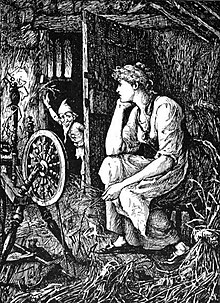 Illustration from Andrew Lang's The Blue Fairy Book (1889) | |
| Folk tale | |
| Name | Rumpelstiltskin |
| Also known as | |
| Country |
|
| Published in | |
"Rumpelstiltskin" (/ˌrʌmpəlˈstɪltskɪn/ RUMP-əl-STILT-skin;[1] German: Rumpelstilzchen [ˌʁʊmpl̩ˈʃtiːltsçn̩] ⓘ) is a German fairy tale[2] collected by the Brothers Grimm in the 1812 edition of Children's and Household Tales.[2] The story is about an imp who spins straw into gold in exchange for a woman's firstborn child.[2]
Plot
[edit]In order to appear superior, a miller brags to the king and people of his kingdom by claiming his daughter can spin straw into gold.[note 1] The king calls for the girl, locks her up in a tower room filled with straw and a spinning wheel, and demands she spin the straw into gold by morning or he will have her killed.[note 2] When she has given up all hope, a little imp-like man appears in the room and spins the straw into gold in return for her necklace of glass beads. The next morning the king takes the girl to a larger room filled with straw to repeat the feat, and the imp once again spins, in return for the girl's glass ring. On the third day the girl is taken to an even larger room filled with straw, and told by the king that if she can spin all this straw into gold he will marry her, but if she cannot she will be executed. While she is sobbing alone in the room, the little imp appears again and promises that he can spin the straw into gold for her, but the girl tells him she has nothing left with which to pay. The strange creature suggests she pay him with her first child. She reluctantly agrees, and he sets about spinning the straw into gold.[note 3]
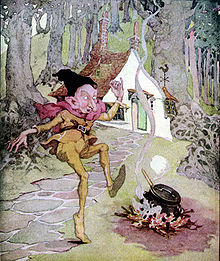
The king keeps his promise to marry the miller's daughter. But when their first child is born, the imp returns to claim his payment. She offers him all the wealth she has to keep the child, but the imp has no interest in her riches. He finally agrees to give up his claim to the child if she can guess his name within three days.[note 4]
The queen's many guesses fail. But before the final night, she wanders into the woods[note 5] searching for him and comes across his remote mountain cottage and watches, unseen, as he hops about his fire and sings. He reveals his name in his song's lyrics: "tonight tonight, my plans I make, tomorrow tomorrow, the baby I take. The queen will never win the game, for Rumpelstiltskin is my name".
When the imp comes to the queen on the third day, after first feigning ignorance, she reveals his name, Rumpelstiltskin, and he loses his temper at the loss of their bargain. Versions vary about whether he accuses the devil or witches of having revealed his name to the queen. In the 1812 edition of the Brothers Grimm tales, Rumpelstiltskin then "ran away angrily, and never came back". The ending was revised in an 1857 edition to a more gruesome ending wherein Rumpelstiltskin "in his rage drove his right foot so far into the ground that it sank in up to his waist; then in a passion he seized the left foot with both hands and tore himself in two". Other versions have Rumpelstiltskin driving his right foot so far into the ground that he creates a chasm and falls into it, never to be seen again. In the oral version originally collected by the Brothers Grimm, Rumpelstiltskin flies out of the window on a cooking ladle.
History
[edit]According to researchers at Durham University and the NOVA University Lisbon, the origins of the story can be traced back to around 4,000 years ago.[3][4][undue weight? – discuss] A possible early literary reference to the tale appears in Dionysius of Halicarnassus's Roman Antiquities, in the 1st century AD.[5]
Variants
[edit]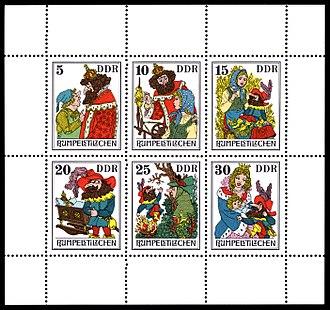
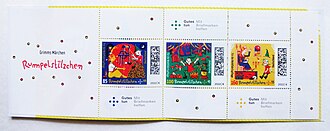
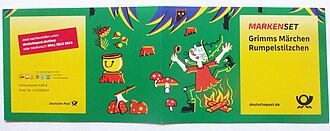
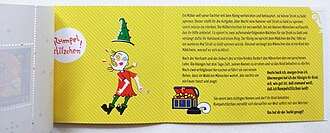
The same story pattern appears in numerous other cultures: Tom Tit Tot[6] in the United Kingdom (from English Fairy Tales, 1890, by Joseph Jacobs); Whuppity Stoorie in Scotland (from Robert Chambers's Popular Rhymes of Scotland, 1826); Gilitrutt in Iceland;[7][8] and The Lazy Beauty and her Aunts in Ireland (from The Fireside Stories of Ireland, 1870 by Patrick Kennedy), though subsequent research [9] has revealed an earlier published version called The White Hen[10] by Ellen Fitzsimon.[11]
The story also appears as جعيدان (Joaidane "He who talks too much") in Arabic; Хламушка (Khlamushka "Junker") in Russia; Rumplcimprcampr, Rampelník or Martin Zvonek in the Czech Republic; Martinko Klingáč in Slovakia; "Cvilidreta" in Croatia; Ruidoquedito ("Little noise") in South America; Pancimanci in Hungary (from 1862 folktale collection by László Arany[12]); Daiku to Oniroku (大工と鬼六 "The carpenter and the ogre") in Japan and Myrmidon in France.
An earlier literary variant in French was penned by Mme. L'Héritier, titled Ricdin-Ricdon.[13] A version of it exists in the compilation Le Cabinet des Fées, Vol. XII. pp. 125–131.
The Cornish tale of Duffy and the Devil plays out an essentially similar plot featuring a "devil" named Terry-top.[14]
All these tales are classified in the Aarne–Thompson–Uther Index as tale type ATU 500, "The Name of the Supernatural Helper".[15][16] According to scholarship, it is popular in "Denmark, Finland, Germany and Ireland".[17]
Name
[edit]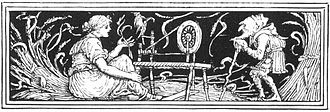
"Rumpelstiltskin" is usually explained as literally meaning "little rattle stilt". The ending -chen in the German form Rumpelstiltschen is a diminutive cognate to English -kin.
Rumpelstilzchen is regarded as containing Stilzchen, diminutive of Stelze "stilt".[18][20] This etymology seems endorsed by Hans-Jörg Uther's handbook on the Grimms Kinder- und Hausmärchen. Uther cites HdA which gives the examples of Bachstelze, Wasserstelze (names of birds; stilt) as paralleling examples.[21][22] However, this was not the etymology hinted at by Jacob Grimm.[23]
Harry Rand's book on this fairy suggests that Rumpel is not just a noise, but originally a crumpling noise, associated with shrunkenness and dwarfness, as apropos for the imp. So the name Rumpel-stilts is an oxymoronic juxtaposition, embodying the dichotomy of "shortness-tallness". Succinctly it may also be rendered as "crumpled stalk". [24]
Brewer's Dictionary of Phrase & Fable baldly and succinctly states it meaning as "wrinkled foreskin" or "prepuce", which correlates with the "crumpled stalk" if stalk is considered as a euphemism.[25]
Grimm suggested -stilt, -stiltchen from Old German stalt with some uncertainty,[23] and did not much elaborate. Graff's dictionary indicates that Rumpelstilts, or rather the form Rumpelstilz was corrupted phonetically towards Stolz 'haughtiness', but the correct etymology points to stalt as Grimm suggested, and this goes to "stal (1)" meaning "locus, location, place" and stellen meaning to "set, place".[26][note 6]
The meaning is similar to rumpelgeist ("rattle-ghost") or poltergeist ("rumble-ghost"), a mischievous spirit that clatters and moves household objects. The name is believed to be derived from Johann Fischart's Geschichtklitterung, or Gargantua of 1577 (a loose adaptation of Rabelais's Gargantua and Pantagruel), which refers to an "amusement" for children, a children's game named "Rumpele stilt oder der Poppart". Thus a rumpelstilt or rumpelstilz was also known by such names as pophart or poppart,[22] that makes noises by rattling posts and rapping on planks. (Other related concepts are mummarts or boggarts and hobs, which are mischievous household spirits that disguise themselves.)
Translations
[edit]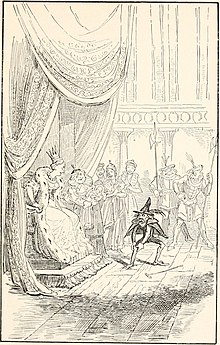
Translations of the original Grimm fairy tale (KHM 55) into various languages have generally substituted different names for the dwarf whose name is Rumpelstilzchen. For some languages, a name was chosen that comes close in sound to the German name: Rumpelstiltskin or Rumplestiltskin in English, Repelsteeltje in Dutch, Rumpelstichen in Brazilian Portuguese, Rumpelstinski, Rumpelestíjeles, Trasgolisto, Jasil el Trasgu, Barabay, Rompelimbrá, Barrabás, Ruidoquedito, Rompeltisquillo, Tiribilitín, Tremolín, El enano saltarín y el duende saltarín in Spanish, Rumplcimprcampr or Rampelník in Czech.
In Japanese, it is transcribed as ルンペルシュティルツヒェン, Runperushutirutsuhyen. The Russian name is close to the original German, Румпельштильцхен, Rumpel'shtíl'tskhen.
In other languages, the name was translated in a poetic and approximate way. Thus Rumpelstilzchen is known as Päronskaft (literally "Pear-stalk") or Bullerskaft (literally "Rumble-stalk") in Swedish,[28] where the sense of stilt or stalk of the second part is retained.
Slovak translations use Martinko Klingáč. Polish translations use Titelitury (or Rumpelsztyk) and Finnish ones Tittelintuure, Rompanruoja or Hopskukkeli. The Hungarian name is Tűzmanócska and in Serbo-Croatian Cvilidreta ("Whine-screamer"). The Slovenian translation uses Špicparkeljc ("Pointy-Hoof").
In Italian, the creature is usually called Tremotino, which is probably formed from the world tremoto, which means "earthquake" in Tuscan dialect, and the suffix "-ino", which generally indicates a small and/or sly character. The first Italian edition of the fables was published in 1897, and the books in those years were all written in Tuscan Italian.
For Hebrew, the poet Avraham Shlonsky composed the name עוּץ־לִי גּוּץ־לִי Utz-li gutz-li, a compact and rhymy touch to the original sentence and meaning of the story, "My-Adviser My-Midget", from יוֹעֵץ, yo'etz, "adviser", and גּוּץ, gutz, "squat, dumpy, pudgy (about a person)"), when using the fairy-tale as the basis of a children's musical, now a classic among Hebrew children's plays.
Greek translations have used Ρουμπελστίλτσκιν (from the English) or Κουτσοκαλιγέρης (Koutsokaliyéris), which could figure as a Greek surname, formed with the particle κούτσο- (koútso- "limping"), and is perhaps derived from the Hebrew name.
Urdu versions of the tale used the name Tees Mar Khan for the imp.
Rumpelstiltskin principle
[edit]The value and power of using personal names and titles is well established in psychology, management, teaching and trial law. It is often referred to as the "Rumpelstiltskin principle". It derives from a very ancient belief that to give or know the true name of a being is to have power over it. See Adam's naming of the animals in Genesis 2:19-20 for an example.
- Brodsky, Stanley (2013). "The Rumpelstiltskin Principle". APA.org. American Psychological Association.
- Winston, Patrick (16 August 2009). "The Rumpelstiltskin Principle". MIT.
- van der Geest, Sjak (2010). "Rumpelstiltskin: The magic of the right word". In Oderwald, Arko; van Tilburg, Willem; Neuvel, Koos (eds.). Unfamiliar knowledge: Psychiatric disorders in literature. Utrecht: De Tijdstroom.
Media and popular culture
[edit]Literature adaptations
[edit]- Gold Spun, a 2021 first novel of a duology by Brandie June.
- Gilded, a 2021 first novel of a duology by Marissa Meyer[29]
- Spinning Silver, a 2018 fantasy novel by Naomi Novik[30]
Film
[edit]- Rumpelstiltskin (1915 film), an American silent film, directed by Raymond B. West
- Rumpelstiltskin (1940 film), a German fantasy film, directed by Alf Zengerling
- Rumpelstiltskin (1955 film), a German fantasy film, directed by Herbert B. Fredersdorf
- Rumpelstiltskin (1985 film), a twenty-four-minute animated feature
- Rumpelstiltskin (1987 film), an American-Israeli film
- Rumpelstiltskin (1995 film), an American horror film, loosely based on the Grimm fairy tale
- Rumpelstilzchen (2009 film), a German TV adaptation starring Gottfried John and Julie Engelbrecht
Ensemble media
[edit]- The 1994 direct-to-video Muppet Classic Theater adapted the story, starring The Great Gonzo as the title character, Miss Piggy as the miller's daughter, and Kermit the Frog as the king. In this version of the story, Rumpelstiltskin reveals that his mother sent him to camp every summer until he was 18. The miller's daughter, who has her father, the king and the king's loyal royal advisor help her guess the name of the "weird, little man", recalls that "a good mother always sews her kid's name inside their clothes before sending them off to camp." Thus, the girl decides to check his clothing, and finds Rumpelstiltskin's name inside.
- "Rumpelstiltskin", a 1995 episode from Happily Ever After: Fairy Tales for Every Child.
- Barney's Once Upon a Time involves the story told by Stella, with Shawn as the title character, Tosha as the miller's daughter, Carlos as the King, and Barney as the messenger.
- Rumpelstiltskin appears as a figment of Chief O'Brien's imagination in the 15th episode "If Wishes Were Horses" of season 1 in the Star Trek: Deep Space Nine.
- Rumpelstiltskin appears as a villainous character in the Shrek franchise, first voiced by Conrad Vernon in a minor role in Shrek the Third. In Shrek Forever After, the character's appearance and persona are significantly altered to become the main villain of the film, now voiced by Walt Dohrn.
- In Once Upon a Time, Rumplestiltskin is one of the integral characters, portrayed by Robert Carlyle. Within the interconnected fairy tale narrative, he acts as a composite character for the Crocodile from Peter Pan, the Beast of Beauty and the Beast and Cinderella's fairy godfather.
- Rumpelstiltskin appears in Ever After High as an infamous professor known for making students spin straw into gold as a form of extra credit and detention. He deliberately gives his students bad grades in such a way they are forced to ask for extra credit.
- The cast of the children's TV series Rainbow acted out the story in a 1987 episode. Zippy played the title character, Geoffrey played the king, Rod played the miller, Bungle played the miller’s daughter, George played the baby, Jane played the maid, and Freddy played a peasant.
- The video game Paper Mario: The Thousand-Year Door has a similar format with the character of Doopliss inspired by Rumpelstiltskin, in which the player has to guess his name correctly, but can only do so by finding the "p" in a chest underground. This reference is more direct in the original Japanese version and other translations, in which the character is named "Rumpel".
Theater
[edit]- Utz-li-Gutz-li, a 1965 Israeli stage musical written by Avraham Shlonsky
- Rumpelstiltskin, a 2011 American stage musical
Notes
[edit]- ^ Some versions make the miller's daughter blonde and describe the "straw-into-gold" claim as a careless boast the miller makes about the way his daughter's straw-like blond hair takes on a gold-like lustre when sunshine strikes it.
- ^ Other versions have the king threatening to lock her up in a dungeon forever, or to punish her father for lying.
- ^ In some versions, the imp appears and begins to turn the straw into gold, paying no heed to the girl's protests that she has nothing to pay him with; when he finishes the task, he states that the price is her first child, and the horrified girl objects because she never agreed to this arrangement.
- ^ Some versions have the imp limiting the number of daily guesses to three and hence the total number of guesses allowed to a maximum of nine.
- ^ In some versions, she sends a servant into the woods instead of going herself, in order to keep the king's suspicions at bay.
- ^ Graff lists as parallel example the German word Hagestolz meaning 'confirmed bachelor', which seems also to contain the steim Stolz 'haughtiness' but is also actually rooted from stalt.[26] The explanatory on this Hagestolz word by Rudolf Steiner and Christopher Bamford is illuminating.[27]
References
[edit]- ^ Wells, John (3 April 2008). Longman Pronunciation Dictionary (3 ed.). Harlow: Pearson. ISBN 978-1-4058-8118-0.
- ^ a b c "Rumpelstiltskin". Encyclopedia Britannica. Retrieved 12 November 2020.
- ^ BBC (20 January 2016). "Fairy tale origins thousands of years old, researchers say". BBC. Retrieved 20 January 2016.
- ^ da Silva, Sara Graça; Tehrani, Jamshid J. (January 2016). "Comparative phylogenetic analyses uncover the ancient roots of Indo-European folktales". Royal Society Open Science. 3 (1): 150645. Bibcode:2016RSOS....350645D. doi:10.1098/rsos.150645. PMC 4736946. PMID 26909191.
- ^ Anderson, Graham (2000). Fairytale in the Ancient World. Routledge. ISBN 9780415237031.
- ^ ""The Story of Tom Tit Tot" | Stories from Around the World | Traditional | Lit2Go ETC". etc.usf.edu.
- ^ Grímsson, Magnús; Árnason, Jon. Íslensk ævintýri. Reykjavik: 1852. pp. 123-126. [1]
- ^ Simpson, Jacqueline (2004). Icelandic folktales & legends (2nd ed.). Stroud: Tempus. pp. 86–89. ISBN 0752430459.
- ^ "On the Trail of an Irish Rumpelstiltskin". www.kieranfanning.com. Retrieved 30 October 2024.
- ^ Duffy's Fireside Magazine. J. Duffy. 1852.
- ^ Ellen Fitzsimon
- ^ László Arany: Eredeti népmesék (folktale collection, Pest, 1862, in Hungarian)
- ^ Marie-Jeanne L'Héritier: La Tour ténébreuse et les Jours lumineux: Contes Anglois, 1705. In French
- ^ Hunt, Robert (1871). Popular Romances of the West of England; or, The Drolls, Traditions, and Superstitions of Old Cornwall. London: John Camden Hotten. pp. 239–247.
- ^ Uther, Hans-Jörg (2004). The Types of International Folktales: Animal tales, tales of magic, religious tales, and realistic tales, with an introduction. FF Communications. p. 285 - 286.
- ^ "Name of the Helper". D. L. Ashliman. Retrieved 29 November 2015.
- ^ Christiansen, Reidar Thorwalf. Folktales of Norway. Chicago: University of Chicago press by 1994 . pp. 5-6.
- ^ Bergler, Edmund (1961). "The Clinical Importance of 'Rumpelstiltskin' as Anti-male Manifesto". American Imago. 18: 66.
- ^ Rinsley, Donald B. (1983). "The Clinical Importance of 'Rumpelstiltskin' as Anti-male Manifesto". Bulletin of the Menninger Clinic. 47: 3.
- ^ Donald B. Rinsley's clinical paper cites Bergler, but states that this association with "stilt" is mistaken.[19]
- ^ Uther, Hans-Jörg (2021) [2010]. "Handbuch zu den "Kinder- und Hausmärchen" der Brüder Grimm: Entstehung – Wirkung – Interpretation". American Imago. 18 (3 ed.). Walter de Gruyter GmbH & Co KG: 132. ISBN 9783110747584.
- ^ a b Jacoby, Adolf (1927). "Boppelgebet". HdA, 1: 1479–1480
- ^ a b Grimm (1875) Deutsche Mythologie 1: 418 n1; Stallybrass tr. (1883) 2: 505n: Rumpelstilt, "stilt, stilz, the old stalt in compounds?"
- ^ Rand (2019), pp. 38–41.
- ^ Brewer's Dictionary of Phrase & Fable. Cassell & Co. 1999. p. 1023. ISBN 978-0-304-35096-4.
- ^ a b Graff, Eberhard Gottlieb (1842) Althochdeutscher Sprachschatz 6, s.v. "Stolz (2)" cross-referenced to "Stal (1)"
- ^ Steiner, Rudolf; Bamford, Christopher (1995) [1920]. The Genius of Language: Observations for Teachers (CW 299). Translated by Ruth Pusch; Gertrude Teutsch. Dornach, Switzerland: Rudolf Steiner Ver;ag. ISBN 978-0-88010-916-1.
- ^ Grimm, Jacob; Grimm, Wilhelm (2008). Bröderna Grimms sagovärld (in Swedish). Bonnier Carlsen. p. 72. ISBN 978-91-638-2435-7.
- ^ Baugher, Lacy (2 November 2021). "Marissa Meyer reimagines Rumpelstiltskin in haunting retelling Gilded". Culturess. Retrieved 16 July 2023.
- ^ Schnieders Lefever, Kelsey (20 April 2020). "'Spinning Silver,' a retelling of 'Rumpelstiltskin,' to be featured Big Read book". www.purdue.edu. Retrieved 16 July 2023.
Selected bibliography
[edit]- Bergler, Edmund (1961). "The Clinical Importance of "Rumpelstiltskin" As Anti-Male Manifesto". American Imago. 18 (1): 65–70. ISSN 0065-860X. JSTOR 26301733.
- Marshall, Howard W. (1973). "'Tom Tit Tot'. A Comparative Essay on Aarne-Thompson Type 500. The Name of the Helper". Folklore. 84 (1): 51–57. doi:10.1080/0015587X.1973.9716495. ISSN 0015-587X. JSTOR 1260436.
- Ní Dhuibhne, Éilis (2012). "The Name of the Helper: "Kinder- und Hausmärchen" and Ireland". Béaloideas. 80: 1–22. ISSN 0332-270X. JSTOR 24862867.
- Rand, Harry (2000). "Who was Rupelstiltskin?". The International Journal of Psychoanalysis. 81 (5): 943–962. doi:10.1516/0020757001600309. PMID 11109578.
- Rand, Harry (2019). Rumpelstiltskin's Secret: What Women Didn't Tell the Grimms. Routledge. ISBN 9781351204149.
- von Sydow, Carl W. (1909). Två spinnsagor: en studie i jämförande folksagoforskning (in Swedish). Stockholm: P.A. Norstedt. [Analysis of Aarne-Thompson-Uther tale types 500 and 501]
- Yolen, Jane (1993). "Foreword: The Rumpelstiltskin Factor". Journal of the Fantastic in the Arts. 5 (2 (18)): 11–13. ISSN 0897-0521. JSTOR 43308148.
- Zipes, Jack (1993). "Spinning with Fate: Rumpelstiltskin and the Decline of Female Productivity". Western Folklore. 52 (1): 43–60. doi:10.2307/1499492. ISSN 0043-373X. JSTOR 1499492.
- T., A. W.; Clodd, Edward (1889). "The Philosophy of Rumpelstilt-Skin". The Folk-Lore Journal. 7 (2): 135–163. ISSN 1744-2524. JSTOR 1252656.
Further reading
[edit]- Cambon, Fernand (1976). "La fileuse. Remarques psychanalytiques sur le motif de la "fileuse" et du "filage" dans quelques poèmes et contes allemands". Littérature. 23 (3): 56–74. doi:10.3406/litt.1976.1122.
- Dvořák, Karel (1967). "AaTh 500 in deutschen Varianten aus der Tschechoslowakei". Fabula (in German). 9 (1–3): 100–104. doi:10.1515/fabl.1967.9.1-3.100.
- Paulme, Denise. "Thème et variations: l'épreuve du «nom inconnu» dans les contes d'Afrique noire". In: Cahiers d'études africaines, vol. 11, n°42, 1971. pp. 189–205. DOI: Thème et variations : l'épreuve du « nom inconnu » dans les contes d'Afrique noire.; www.persee.fr/doc/cea_0008-0055_1971_num_11_42_2800
External links
[edit] The full text of Rumpelstiltskin at Wikisource
The full text of Rumpelstiltskin at Wikisource The full text of Tom Tit Tot at Wikisource
The full text of Tom Tit Tot at Wikisource- The complete set of Grimms' Fairy Tales, including Rumpelstiltskin at Standard Ebooks
- Free version of translation of "Household Tales" by Brothers Grimm from Project Gutenberg
- 'Tom Tit Tot: an essay on savage philosophy in folk-tale' by Edward Clodd (1898)
- Parallel German-English text in ParallelBook format
- 1985 TV movie
- Rumpelstiltskin
- Grimms' Fairy Tales
- Goblins
- Fairy tales about goblins
- Fairy tales about dwarves
- Fairy tales about magic
- Fairy tale stock characters
- Male characters in fairy tales
- Male literary villains
- Fictional German people
- Fictional characters who use magic
- Folklore featuring impossible tasks
- ATU 500-559
- Imps
